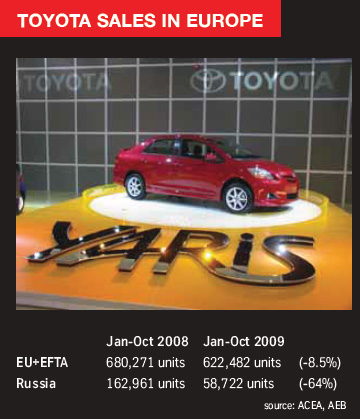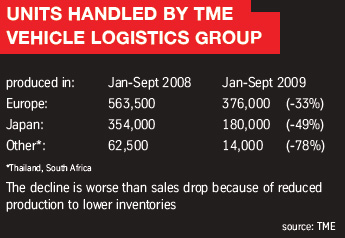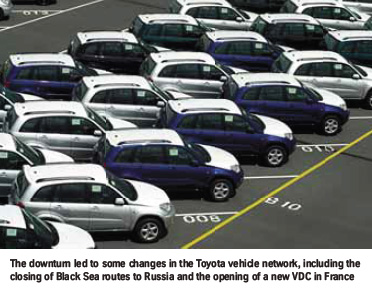Toyota’s recent struggles in Europe had forced the carmaker to revert to short-term strategies for its outbound operations. But, as Emile Benaim explains to Christopher Ludwig, he is worried some providers are pricing themselves too low to survive.
There are many reasons why a logistics provider might fail in its bid to gain business with a carmaker: poor visibility across the supply chain from out-of-date IT systems; a lack of experience in a certain market; or, the most familiar, offering the wrong price. But a provider might be surprised to learn that its quote was too low, rather than too high. But that is precisely the words that have been on the lips of Emile Benaim, Toyota Motors Europe’s (TME) director of vehicle logistics. In a European market flooded with excess transport capacity this year, Benaim has seen new entrants try their best to undercut one another in a price war for the business in play, in some cases offering deals at such low prices that they are, in his words, “really crazy”. For Benaim, an industry veteran with more than 20 years sales, marketing and logistics experience with Ford, Fiat and Toyota, those offers are tempting. Although TME’s mother company, Toyota Motor Corporation, registered a surprise profit in the July-September quarter, it remains in the red for the year, with TME’s losses at the financial half year at ¥18.6 billion ($206m, €139m).

But logistics service at too low a price is also dangerous. Benaim is not convinced that the offers made by some of the providers are sustainable and he fears that, in the long run, logistics providers might not be able to maintain the service. “We have to be fair, because if someone is making a competitive offer and we don’t select them, then we have to explain why. It is not easy to say that a company made a good proposal but we think it’s ‘too low’,” he says, laughing at what in the logistics sector is often considered an absurd statement for OEMs to make. But Toyota has built a strong reputation for supplier relations and Benaim, who took over responsibility for vehicle logistics in 2008, is unwilling to preside over the decline of those relations with logistics providers. “It is difficult to express, but I do not want to take business away from a valued supplier, even to save 20%,” he says. “We have some partners
with which we’ve had relationships for years, who were there when we needed them, and didn’t increase prices by 10% just because they were the only ones that had the capacity [at the time]. “We would hate to give even part of those providers’ business to other companies,” he adds. But Benaim admits that he is paying close attention to his current tenders. While it would not be typical of Toyota to take a short-term price cut, “There is a risk it could happen, as it is not always easy to avoid picking the cheapest option.”
Road carriers need to speak up if they want to slow down
Benaim says that he really wants a new way of doing business – one that might allow carmakers and logistics providers to understand each other better, including a more honest discussion about price, service expectations and financial difficulty. Currently he finds this openness lacking.
For example, he reveals his surprise that, despite the low volumes, more road carriers have not challenged some of the traditional criteria that Toyota uses in tenders and contracts, including strict lead-time requirements. “Surprisingly, I have not seen the impact of lower volumes on lead time for trucking companies, as most are still meeting and offering the same levels,” he says. “Not one provider has come to us following our instructions and said that they could not meet the lead time because volumes are too low. I would have expected this.” Lower volumes create gaps and inefficiencies in the transport network, leading to more empty hauls or half-full trucks, which can be avoided in some cases by prolonging delivery times or to allow time to fill assets with more cargo.

TME sales were down about 19% after ten months in 2009 including Russia and Turkey, while for the vehicle logistics group the drop is more dramatic because of steep production cuts: at the same time in 2008 Benaim’s team had moved 980,000 vehicles, down to 570,000 this year. But despite that, providers have made no lead-time adjustments, he says. By contrast the shipping lines have not only trimmed capacity, but have slowed ships, cut service and added extra stops to make sure the routes remain profitable.
While manufacturers are not always happy about the longer journey times, which have increased the lead time for Toyota vehicles imported from Japan, they live with them. Benaim is not quite willing to say that he would automatically accept longer lead times for land transport. He gives an example of a case earlier in 2009 when the company was faced with the option of cutting costs at the expense of a significant lead time increase to one market. While he does not specify the country or transport mode, he does say that, after considering the input of the national sales company, which opposed the idea, Toyota rejected the offer. But he nevertheless wonders if there might be scope to make some smaller concessions on lead-time. “I wonder, mostly to myself, whether we should be more willing to accept trade offs in future,” he says. “Everybody is looking for efficiency and cost savings, so maybe it is stupid to keep asking for more service at the same cost or even less. “Maybe, for example, we should accept delivering cars in four or five days rather than two or three, if the result is that we lower the cost and make it easier for everyone.” But interestingly, although such a proposal has been suggested by logistics companies on the pages of this magazine and at conferences (most recently the ECG’s annual event in Rotterdam) not a single provider has suggested it at the negotiating table to Benaim, nor attempted to quantify the benefits and drawbacks.

A missed opportunity and deferred risk?
Perhaps logistics providers are scared to show any weakness, particularly in the current, cutthroat market. A market full of “crazy offers” might not encourage providers to go to Toyota with suggestions for slower service. And Benaim admits that Toyota too might have missed a chance by not suggesting it for them. “We were not brave enough to trigger this discussion ourselves, and maybe it is a missed opportunity. Perhaps it is time to work on this together [with providers].”
Such trade offs might be better for the long-term viability of the sector’s performance. While the ability of providers to
provider took Toyota up on its offer. “I brought the message that if there is a risk, they should tell us. We were prepared to help them survive, even financially to an extent, but nobody said so,” he says. “Everyone said they had countermeasures in place, from cutting sub-contractors, to new arrangements with the bank. “I was amazed. I’m still wondering if we have simply postponed the risk.”

At the time of writing, Europe has still managed to avoid seeing a single medium-sized or larger finished vehicle provider go bankrupt or out of business, a resilience that impresses Benaim. And while that has largely come at the expense of the capacity of many smaller players and subcontractors, Benaim does not share the view by some logistics providers that Europe could face another transport capacity shortage as volumes recover. In Toyota’s view, the market will take quite a few years to approach former levels, with recovery slow and uncertain. The end of many incentive programmes in Europe in the coming months will add to the uncertainty. “Unfortunately, I think we have time to adapt to the new [capacity standard],” Benaim says.
For Benaim, the concern is more about the viability of providers in the difficult times ahead. To ease this pain, he believes that logistics providers will have to be more open and honest with him about where they are struggling. “I really would expect more LSPs to come to us and say that we are having trouble and we can’t do this, etc.” He pauses, smiling. “Maybe I shouldn’t be telling you this because now they will really come to me! But I would prefer to have the open discussion.”
But it’s still business as usual
Benaim’s vehicle logistics group is responsible for the movement of Toyota vehicles produced from its plants in France, the UK, the Czech Republic, Portugal and Turkey, as well as imports once they enter port in Europe (St Petersburg production is the responsibility of Toyota Russia), as well in a network of eight vehicle distribution centres. Since 2000, TME has been gradually centralising vehicle distribution from its Brussels headquarters, taking it away from national sales organisations. It currently controls the movement of vehicles up to each retailer in Germany, France, Spain, Belgium, the Netherlands, Hungary, the Czech Republic, the Baltic states and the Nordic markets. For other markets, TME is responsible for delivering cars to national compounds, where national sales companies perform the domestic logistics. Aside from several tweaks, the above structure has more or less been in place for several years, and Benaim reveals that, despite his ambition for a new way of doing business, like its providers little has really changed in TME’s wider business strategy despite the recent turmoil.
That might sound surprising, considering the losses that have partly resulted from the Achilles heel in Toyota’s global strategy: a high proportion of Japanese production combined with an escalating yen. But Benaim maintains that there have been few changes in the logistics network, and the crisis has not prompted Toyota to shift more production to Europe beyond market demands. There is also very little change in transport modes, despite the drop in volumes, lower road rates and longer lead times from Japan, for example.
Finally, somewhat different from what other OEMs have said of late, nothing has changed the basic Toyota approach to production and inventory levels despite it leading to a logistics crisis earlier in 2009, including periods when vehicle stocks overflowed in factories, ports, distribution centres and even on vessels hired as floating car parks.
A closer look at the network
To be fair, when Benaim says “nothing”, he is talking at a high level, where Toyota has not fundamentally changed its approach to distribution, inventory, transport mode or logistics partners. A closer look reveals that production this year has tilted more toward Europe then in the past. In the first three quarters of 2009, 66% of vehicles (376,000) delivered by Benaim’s group were built in Europe, including Turkey, compared to 57.5% (563,500) last year. But this change is a reflection of the demand for small cars Toyota builds in Europe, particularly the Aygo, produced only in the Czech Republic, and the Yaris, which can be built in France as well as Japan. Most other models come from Japan, apart a small amount (14,000, or 2.5%) from Thailand and South Africa. “The strategy has always been to saturate the French plant first before ordering from Japan. But obviously French production is not at full capacity so there has been no reason to order extra cars from Japan,” he says. “But our policy is exactly the same.”
Part of the reason for maintaining a large balance of Japanese production is that Toyota’s lead time for a vehicle ordered in a European plant is nearly the same as that of one ordered from Japan. Certain material still comes from Japan and Toyota’s low inventory production system means that it must order those parts at the same time as a new vehicle. But Benaim reveals that TME is piloting a new system that, combined with more material from Europe, should lower the lead-time for European plants. But for now, at least, the situation is unchanged.
For the logistics network Toyota has also reacted to the market in areas. It has closed certain import routes to Russia, including in Poland at the Port of Gdansk as well as the Black Sea route by way of the Ukrainian Port of Ilyichevsk. In France, meanwhile, it began using an entirely outsourced vehicle distribution centre in Sete during September to handle the import of Turkish-built cars for the French market.
Have other OEMs changed more, or just said so?
But otherwise, Benaim says that he has been interested to hear about some of the larger changes claimed by rival OEMs, particularly that they have drastically reduced vehicle inventory. “I was amazed to read about OEMs that said they had vehicle inventory 50% lower than they had before,” he says. “We have come down too [from peaks early in 2009] but only to normal levels.”
Toyota has typically carried among the lowest levels of vehicle inventory compared to other OEMs, most of which have said long before the crisis that they would lower inventory, but rarely do. As a built-to-stock, volume producer with a large number of imports from Japan, Toyota depends on a certain vehicle stock level that Benaim does not believe should come down.
He is also surprised to hear about OEMs in Europe switching transport modes. According to sources at both European-based OEMs and LSPs, there has been a move to road for lower cost as well as to accommodate reduced volumes without reducing lead time, even for moving long distances in some cases. Both GM and Gefco, for example, have admitted switching to road from rail or sea to Russia, from as far away as Spain in some cases.
While Toyota has also faced longer lead times from Japan, it has not tried to push the vehicle faster once in Europe. “I suspect that some OEMs have actually been more creative than us when it comes to switching modes and being more flexible,” he says. By contrast, Toyota’s rail use in Europe has actually increased in the past year, albeit from low levels. Taking into account both kilometres travelled with the number of vehicles, rail has grown from about 5% of transport to 13%. Vessel transport (from port of entry) has remained stable, at around 67%, while road is down to 20% (from close to 30%). The reduced road figure might also be the result of closing some of the lanes to Russia, for example, where vehicles were trucked from Gdansk to Moscow. But again it was not an intended consequence. “The rise in rail was not really strategic,” Benaim says. “I was surprised myself when I did the calculations.”
Time for a change for TPS?
But there are questions as to whether the crisis should lead to more strategic production and logistics change for the world’s largest carmaker.
In the Toyota Production System (TPS), stability is valued above all. Production schedules are protected, and kept simple and rigid to maintain quality and keep the lowest stock levels. Toyota’s strict ordering process, while not without some manoeuvrability, is more orientated toward a steady push than a pull from the market. For vehicle logistics, the emphasis has been on the shortest lead times, with few cars assigned to customers from the factory, or indeed before they are exported, but allocated as close to their arrival in ports, hubs or regional sales centres as possible.
“We do lack flexibility in some ways,” admits Benaim. “I don’t really know if we were worse than any other company, but our perception is that we were worse than the average when it came to reacting and cutting production. It took a lot of time to analyse the market and it certainly led to a very visible stock problem.”
For logistics, this problem led also to inefficiencies across the outbound chain. As cars sat longer, damage rates rose. Cars could not be parked in the best order, and suffered from poorer visibility, meaning that even when those precious sales orders came in, it took Toyota more time, stress and cost to move them. The same applied when sales were low as well as when they rocketed thanks to incentives, such as for Germany. The OEM was not alone in these troubles – the European sector was overstocked in general, and Asian exporters had less time to manoeuvre supply chains – but for a company that had done so much right in recent years, it was a humbling misstep. While Toyota ranks among the most efficient companies in the world, particularly for its inbound logistics, should the problems revealed in the crisis have brought about a wider rethink, particularly on the distribution side? “I’ve been thinking a lot about this because I knew that you were going to ask the question. And I know, I can see why you would ask it, considering the unprecedented situation,” Benaim says. “But nothing has really changed.”
But Benaim expresses something of a conflict. While TPS is considered one of the industry’s gems, Benaim does see much room for improving outbound, not least making pickup and drop-off times more precise. However he admits that in at least some areas, the crisis has forced Toyota to focus more on short-term cost cutting than it had before. Benaim does not hide his frustration.
“We shifted our mindset to plan for the short term,” he says. “When I say ‘no strategic change’ it also means that we were not able to do the strategic changes that we wanted to do.” Plans that were shelved include certain improvement activities around vehicle handling and storage operations. “Because of the extra costs and stress that we were spending, it also meant that where we had ongoing kaizen [improvement] activities, it all had to stop,” he says. “It is only recently that we could start again with it.”
The door is open for providers
It is a sign of the difficulty of the times to hear that Toyota has had to pull back from that overused but nevertheless magic word, kaizen, it has bequeathed to corporate managers. And Benaim acknowledges that the ‘no change’ strategy prevented or has delayed even more fundamental improvements that Benaim would like to see within Toyota management for how it interacts with service providers.

For example, Toyota retains a cautious approach to outsourcing, where planning, processes and indeed, kaizens are guarded closely and developed in-house. He admits that Toyota’s usual method has been to go to providers with ideas rather than encourage the other way around. But Benaim wants to open up the relationship. One idea would be to extend his management team’s knowledge about commercial trucking, among other operations, which he admits is inadequate.
That education could include an “open book” relationship with a provider, or even developing an in-house fleet, such as Toyota has done in North America, to use as template for interacting with other providers. “That was one of the areas that I wanted to explore further, and might again in the future,” he says. “Right now we lack those specific skills and knowledge related to the business of our LSPs, and [an in-house fleet] would have been one way to learn this.
“It could give us a different way to work with our providers and also in tenders,” he adds. Such a measure will have to wait until there is more stability in the market. In the meantime, Benaim wants to see the company focus more on its relationship with logistics providers, creating an atmosphere where they are more willing to approach Toyota with ideas and to be honest about their businesses. Perhaps this interview is as good a place as any to begin such a discussion.
“I’m not trying to get a discount, but I’m really trying to find a new way of doing business,” he says. “I think it should be Toyota’s responsibility to stimulate this discussion. Can we really continue with business as usual?”







































